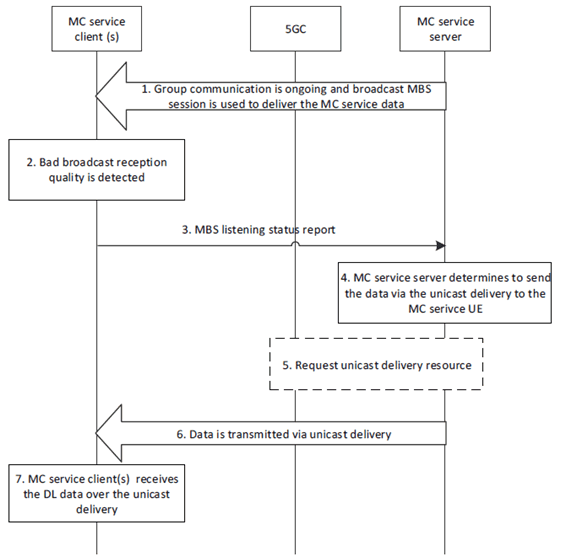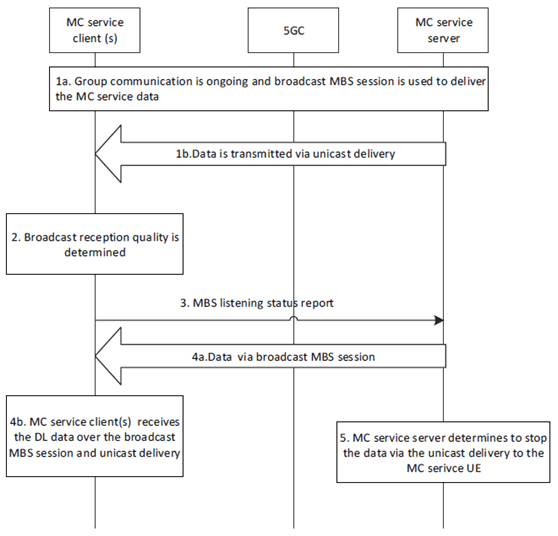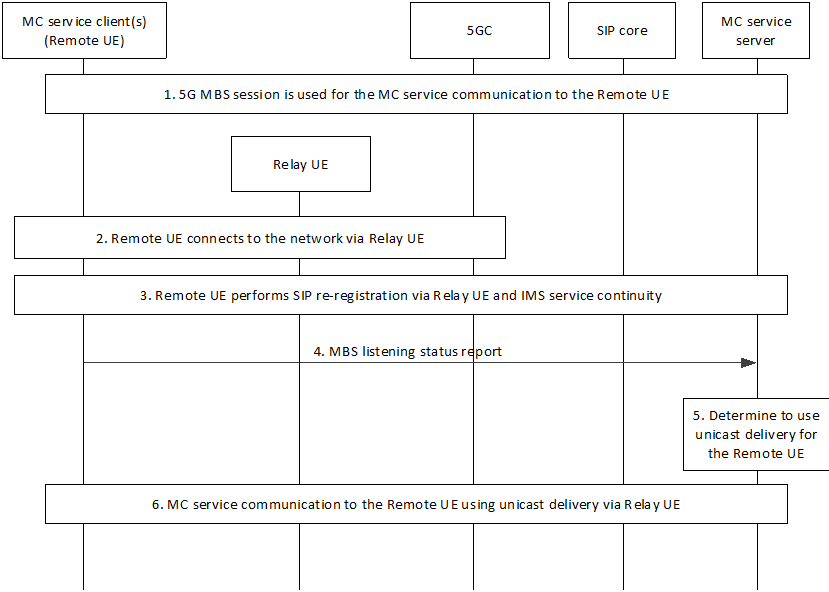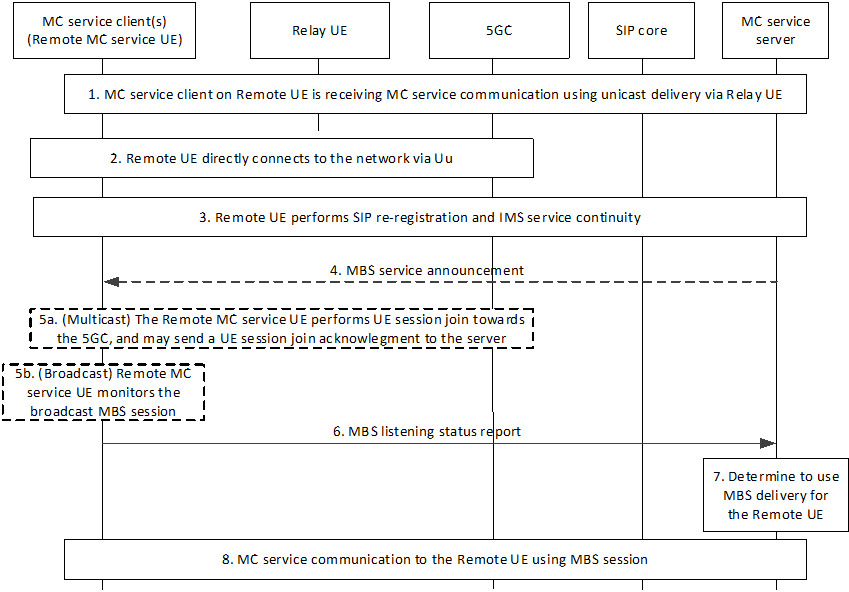Content for TS 23.289 Word version: 19.0.0
0…
4…
4.7…
4.7.4…
4.8…
5…
5.4…
6…
6.3…
6.3.2…
7…
7.2.4…
7.3…
7.3.3…
7.3.3.2…
7.3.3.4…
7.3.3.5…
7.3.3.7…
7.3.3.8…
7.3.3.9…
7.3.3.10…
7.3.3.11…
7.3.3.12…
7.3.3.13…
7.4…
7.5…
7.6…
A…
7.3.3.8 Service continuity between 5G MBS delivery and unicast delivery
7.3.3.8.1 General
7.3.3.8.2 Service continuity for broadcast MBS session
7.3.3.8.2.1 General
7.3.3.8.2.2 Procedures
7.3.3.8.2.2.1 Service continuity from broadcast to unicast
7.3.3.8.2.2.2 Service continuity from unicast to broadcast
7.3.3.8.3 Service continuity for multicast MBS session
7.3.3.8.4 Path switch between MBS session and 5G ProSe UE-to-network relay
7.3.3.8.4.1 General
7.3.3.8.4.2 Path switch procedure from MBS session to a 5G ProSe UE-to-network relay
7.3.3.8.4.3 Path switch from a 5G ProSe UE-to-network relay to MBS session
...
...
7.3.3.8 Service continuity between 5G MBS delivery and unicast delivery p. 76
7.3.3.8.1 General p. 76
This clause addresses the issue of MC service media delivery over MBS session, specifically, to maintain the service continuity when switching between 5G MBS delivery and unicast delivery.
7.3.3.8.2 Service continuity for broadcast MBS session p. 77
7.3.3.8.2.1 General p. 77
The MC service client reports the broadcast reception quality to the MC service server which is used to make the decision whether to use the unicast delivery to the MC service UE(s) which are suffering bad broadcast reception quality due to e.g., move out of the broadcast service area.
An MC service client monitors the broadcast MBS session to receive MC service media. Based on the received quality (e.g., radio level quality, RTP packet loss), the MC service client needs to inform the MC service server that the MC service client is able to receive the MC service media on the broadcast MBS session with sufficient quality or not.
This estimation of the broadcast reception quality may be dependent on, for example, the modulation and coding scheme (MCS) and measurements from the reference signals from the NG-RAN node(s), RTP packet loss, BLER of the received media.
7.3.3.8.2.2 Procedures p. 77
The procedure in Figure 7.3.3.8.2.2.1-1 illustrates the UE which is receiving media via broadcast MBS session is switched to unicast delivery because the UE suffers from bad broadcast reception quality due to e.g., moving out of the broadcast service area. It shows only one of the receiving MC service clients receiving the broadcast MBS session.
Pre-conditions:
- The MC group communication is ongoing and the MC service media (e.g., DL media, application layer control signalling) is transmitted via broadcast MBS session.
- The MC service client is receiving the MC service media (e.g., DL media, application layer control signalling) via the broadcast MBS session.
- The MC service client(s) already have the associated information (e.g., SDP) to receive the unicast delivery during the group communication establishment phase.

Figure 7.3.3.8.2.2.1-1: Service continuity from broadcast to unicast
(⇒ copy of original 3GPP image)
(⇒ copy of original 3GPP image)
Step 1.
An MC service group communication session is ongoing and the DL media is transmitted over broadcast MBS session.
Step 2.
The MC service client detects that it suffers bad broadcast reception due to e.g., moving out of the broadcast service area of the announced MBS session ID (i.e., TMGI). The MC service client may determine the broadcast reception quality by using the BLER of the received media. When no media is received, the quality estimation can consider the reference signals and the modulation and coding scheme (MCS).
Step 3.
The MC service client sends MBS listening status report which indicates the broadcast reception quality associated with the MBS session ID is not sufficient to receive media. The MC service client may also map the determined broadcast reception quality to a broadcast reception quality level. The broadcast reception quality level indicates at which specific broadcast reception quality level the MC service media has been received.
Step 4.
The MC service server based on the report from the participant, determines that the UE is not able to receive the media or the QoS requirements is not satisfied. The MC service server determines to send the MC service media (e.g., DL media, application layer control signalling) via the unicast delivery to the reported MC service client.
Step 5.
If the unicast QoS flow is not satisfied, the MC service server interacts with the 5GC to update the QoS requirements.
Step 6.
The MC service server sends the MC service media via the unicast delivery towards the MC service client which suffers bad broadcast reception quality.
Step 7.
The MC service client then receives the DL MC service via both broadcast MBS session and unicast delivery.
The procedure in Figure 7.3.3.8.2.2.2-1 illustrates the UE receiving media via unicast delivery being switched to broadcast MBS session as the UE enters the broadcast service area where the NG-RAN is broadcasting the MC service media of the ongoing group communication. The MC service client now is able to receive the broadcast media. Only one of the receiving MC service clients receiving the broadcast MBS session is shown.
Pre-conditions:
- The MC group communication is ongoing and the MC service media (e.g., DL media, application layer control signalling) is transmitted via broadcast MBS session in the broadcast service areas.
- The MC service client is receiving the MC service media (e.g., DL media, application layer control signalling) via the unicast delivery.
- The MC service client has already received the broadcast MBS session announcement, MapGroupToSessionStream information and enters the broadcast service area.

Figure 7.3.3.8.2.2.2-1: Service continuity from unicast to broadcast
(⇒ copy of original 3GPP image)
(⇒ copy of original 3GPP image)
Step 1.
An MC service group communication session is ongoing and the broadcast MBS session is used to deliver the MC service media of the group communication. The MC service client is receiving the MC service media via the unicast delivery.
Step 2.
The MC service client detects that it is able to receive the broadcast media due to e.g., moving into the broadcast service area of the announced MBS session ID. The MC service client may determine the broadcast reception quality by using the BLER of the received media. When no media is received, the quality estimation can consider the reference signals and the modulation and coding scheme (MCS).
Step 3.
The MC service client sends MBS listening status report which indicates the broadcast reception quality associated with the MBS session ID is sufficient to receive media. The MC service client may also map the determined broadcast reception quality to a broadcast reception quality level. The broadcast reception quality level indicates at which specific broadcast reception quality level the MC service media has been received.
Step 4.
Based on the MapGroupToSessionStream received before, the MC service client receives the DL MC service via both the broadcast MBS session and the unicast delivery.
Step 5.
The MC service server, based on the report from the participant, determines to stop sending the MC service media (e.g., DL media, application layer control signalling) via the unicast delivery to the reporting MC service client. After then, the MC service client receives the MC service media only via the broadcast MBS session.
7.3.3.8.3 Service continuity for multicast MBS session p. 80
7.3.3.8.3.1 General p. 80
The MC service server may also switch between multicast and unicast by utilizing application layer mechanisms similar to switching between broadcast and unicast as specified in clause 7.3.3.8.2. If indicated in the MBS session announcement information, the MC service client reports the monitoring state (i.e., the reception quality of the MBS session) back to the MC service server.
7.3.3.8.4 Path switch between MBS session and 5G ProSe UE-to-network relay p. 80
7.3.3.8.4.1 General p. 80
The MC service communications over 5G ProSe UE-to-network relay is supported for unicast delivery.
The path switch procedures for MC service communications between MBS session and 5G ProSe UE-to-network relay is specified in this clause.
The architecture of MC service utilizing IMS service continuity is specified in Annex B.
7.3.3.8.4.2 Path switch procedure from MBS session to a 5G ProSe UE-to-network relay p. 80
This clause describes the procedures for path switch from MBS session to a 5G ProSe UE-to-network relay.
Figure 7.3.3.8.4.2-1 illustrates the path switch procedure from MBS session to a 5G ProSe UE-to-network relay.

Figure 7.3.3.8.4.2-1: Path switch from MBS session to a 5G ProSe UE-to-network relay
(⇒ copy of original 3GPP image)
(⇒ copy of original 3GPP image)
Step 1.
The DL media is transmitted over an MBS session to a (remote) MC service client.
Step 2.
The MC service client sends an MBS listening status report indicating that the MBS reception quality associated with the MBS session ID is not sufficient to receive media. The MC service client may also map the determined MBS reception quality to an MBS reception quality level. The MBS reception quality level indicates at which specific MBS reception quality level the MC service media has been received.
Step 3.
The MC service server based on the report from the MC service client determines that the (remote) MC service UE is unable to receive the media or the QoS requirements are not satisfied. The MC service server determines to send the MC service communications (e.g., DL media, application layer control signalling) via the unicast delivery to the reported MC service client.
Step 4.
The MC service server sends the DL media to the (remote) MC service UE over a unicast PDU session.
Step 5.
The remote MC service UE discovers and utilizes a 5G ProSe UE-to-network relay UE in its proximity once it has detected being out of the network coverage. This step applies to both 5G ProSe Layer-3 and Layer-2 UE-to-network relay.
Step 6.
For the case of 5G ProSe Layer-3 UE-to-network relay without the support of N3IWF, as described in TS 23.304, the remote MC service client performs SIP re-registration over the relay UE due to the change in IP address of the remote MC service UE and initiates IMS service continuity procedures as described in Annex B.
Step 7.
The MC service server sends the MC service communications using the unicast delivery via the 5G ProSe MC service UE-to-Network relay UE towards the remote MC service client. The MC service client then receives the DL MC service communication via the relay UE.
7.3.3.8.4.3 Path switch from a 5G ProSe UE-to-network relay to MBS session p. 82
This clause describes the procedure for path switch from a 5G ProSe UE-to-network relay to MBS session.
Figure 7.3.3.8.4.3-1 illustrates path switch from a 5G ProSe UE-to-network relay to MBS session.

Figure 7.3.3.8.4.3-1: Path switch from a 5G ProSe UE-to-network relay to MBS session
(⇒ copy of original 3GPP image)
(⇒ copy of original 3GPP image)
Step 1.
The remote MC service client is receiving the MC service media using the unicast delivery via a 5G ProSe UE-to-Network relay UE. This step applies to both 5G ProSe Layer 3 and Layer 2 UE-to-network relay.
Step 2.
Based on the (remote) MC service UE`s path selection policies described in TS 23.304, and once the NG-RAN based measurement report discussed in TS 38.331 is triggered due to network coverage detection,the (remote) MC service UE connects to the network via the Uu-interface.
Step 3.
For the case of 5G ProSe Layer-3 UE-to-network relay without the support of N3IWF, the (remote) MC service client performs SIP re-registration over Uu and initiates the IMS service continuity procedures as described in Annex B. Further, the MC service server sends MC service communications using unicast delivery which traverses over Uu to the remote MC service client.
Step 4.
The MC service client receives the MC service communication over a unicast PDU session.
Step 5.
Optionally, the MC service server may send the MBS session announcement to the (remote) MC service client with the information of the MBS session.
Step 6a.
If a multicast MBS session has been announced, the MC service UE performs a UE session join towards the 5GC using the MBS session information, and the MC service client may send a UE session join notification towards the server.
Step 6b.
If a broadcast MBS session has been announced, the MC service client start monitoring the reception quality of the broadcast MBS session.
Step 7.
The MC service client sends an MBS listening status report which indicates the MBS reception quality associated with the MBS session ID is sufficient to receive media.
Step 8.
Based on the report received from MC service client in step 7, the MC service server determines to stop sending the MC service communications (e.g., DL media, application layer control signalling) using the unicast delivery. Further, the MC server sends the MC service communications via the MBS session.
Step 9.
The MC service client receives the MC service communications from the MC service server via the MBS session.